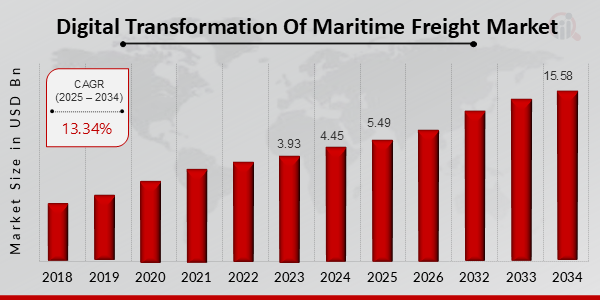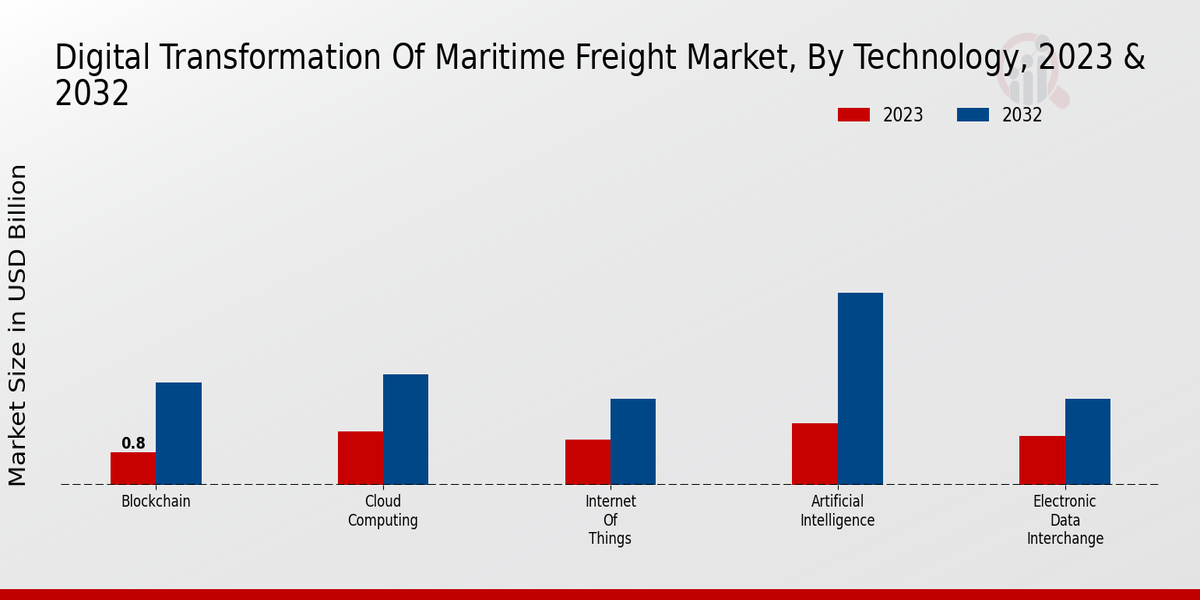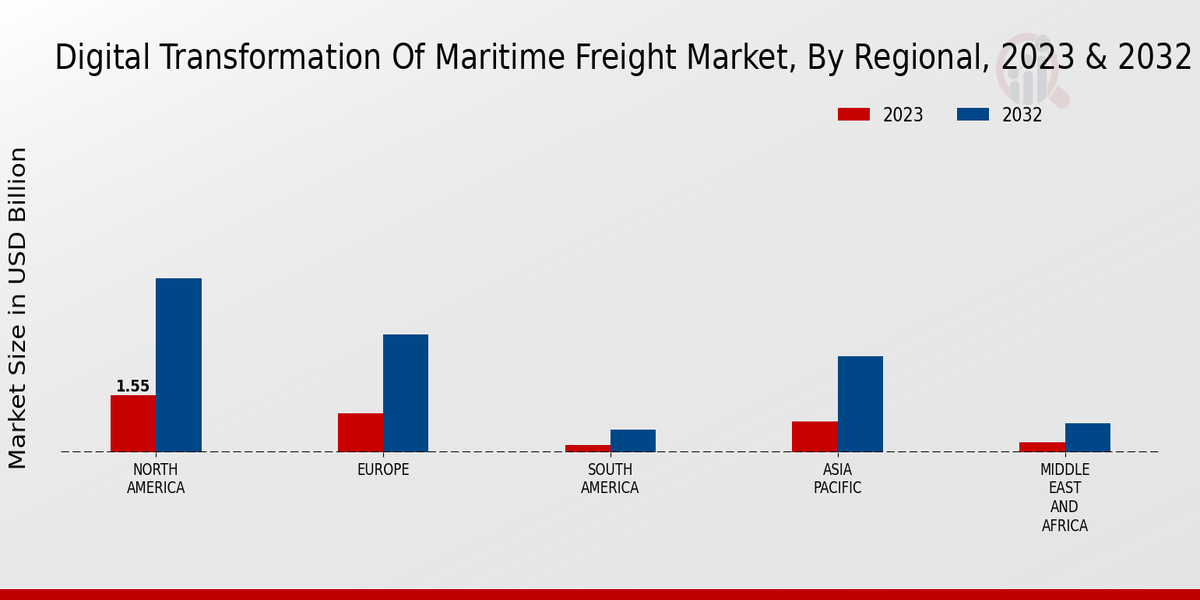Digital Transformation of Maritime Freight Market Overview
Digital Transformation Of Maritime Freight Market is projected to grow from USD 5.49 Billion in 2025 to USD 15.58 Billion by 2034, exhibiting a compound annual growth rate (CAGR) of 13.34% during the forecast period (2025 - 2034). Additionally, the market size for Digital Transformation Of Maritime Freight Market was valued at USD 4.45 billion in 2024.
Key Digital Transformation of Maritime Freight Market Trends Highlighted
The maritime freight industry is experiencing a surge in digital transformation, driven by the need to optimize operations, reduce costs, and enhance customer service. Key market drivers include the adoption of technologies such as artificial intelligence, blockchain, and cloud computing, as well as the demand for increased visibility and transparency. Opportunities to capture include developing solutions that improve supply chain efficiency, enable predictive maintenance, and enhance data analytics. Recent trends include the emergence of autonomous ships, smart ports, and digital marketplaces, which are transforming the way freight is transported and handled. Through these innovations, the digital transformation of maritime freight is poised to revolutionize the industry, leading to improved safety, reduced environmental impact, and increased profitability for stakeholders.
Figure 1: Digital Transformation Of Maritime Freight Market Size, 2025-2034 (USD Billion)

Source: Primary Research, Secondary Research, MRFR Database and Analyst Review
Digital Transformation of Maritime Freight Market Drivers
Increasing Demand for Efficiency and Transparency in Maritime Freight Operations
The maritime freight industry experiences rising pressure to enhance the efficiency and transparency of its operations. The phenomenon is driven by numerous factors, such as huge trade volume increases, complex growth for supply chains, and increasing pressure to cut the costs of operations. These challenges open up enormous opportunities for the industry of digital transformation of maritime freight. Digital transformation offers a number of tools and technologies that can enhance the overall visibility, traceability and efficiency of supply chains.
For instance, digital platforms enable tracking of goods’ movements in real-time, thus providing shippers with up-to-date information about their supply chains. Such information sharing can lead to faster detection and consequent resolution of possible problems, as well as enhanced inventory management. Technologies such as blockchain allow for automation of a number of processes required for the transport of goods, such as documentation and customs clearance.
This, in turn, leads to cost reductions. To conclude, the rising pressure to enhance the level of efficiency and transparency of maritime freight operations is one of the key driving forces behind the development of the Digital Transformation of Maritime Freight Market Industry.
Growing Adoption of Cloud-Based and SaaS Solutions
The use of cloud-based and software-as-a-service solutions is increasingly widespread in the maritime freight industry. On the one hand, this is determined by the increased availability of reliable and relatively cheap cloud computing services. On the other hand, it is related to the need for scalability and flexibility that such solutions can offer. In particular, companies involved in maritime freight are likely to benefit from the following features of cloud-based and SaaS solutions: Flexibility and scalability: Such information technology solutions can be easily enlarged or reduced in order to meet the needs of a certain company.
It depends on the fact that it is possible to rent or dismiss certain physical servers which are to be retained in the data center where the SaaS system is installed. This framework may be useful for various reasons, and companies involved in maritime freight may benefit particularly from it, as the demand for their services may largely vary from season to season. Reduction of costs: As demand changes, costs may also be reduced significantly due to the SaaS or cloud-based solutions.
In fact, buying new hardware and software requires considerable initial investments, which can sometimes be unaffordable for smaller companies. At the same time, renting certain solutions from an IT provider requires no initial investment, which may give a great advantage to certain competitors in the market of maritime freight. Improving the level of collaboration: companies involved in maritime freight may also benefit from the use of SaaS and cloud-based solutions in terms of enhancing collaboration and coordination of activities.
In particular, such technologies can be used to share files or data between shippers and carriers or carriers and logistics companies. As a result, this can improve communication and coordination and reduce costs.
Government Regulations and Initiatives
There are also some regulations and initiatives provided by governments that are driving the growth of the Digital Transformation of Maritime Freight Market Industry. The International Maritime Organization has provided several regulations that require maritime freight companies to enhance safety and efficiency. Such regulations are the International Convention for the Safety of Life at Sea and the International Convention for the Prevention of Pollution from Ships.
Hence, digital transformation can lead to necessary compliance with these regulations. For instance, digital platforms that can help to monitor the location of freight in real-time help to prevent accidents and improve search and rescue operations. Moreover, thanks to these platforms it is possible to monitor emissions and improve the fuel efficiency of freight in order to reduce the environmental impact.
Digital Transformation Of Maritime Freight Market Segment Insights
Digital Transformation of Maritime Freight Market Technology Insights
Technologies form an essential component of the Digital Transformation of Maritime Freight Market, facilitating its growth and increasing its development rates. Key technologies include Electronic Data Interchange (EDI), Blockchain, Artificial Intelligence, Internet of Things and Cloud Computing. The digital transformation of maritime freight market for EDI technology is expected to attain $1.2 billion by 2023 with a CAGR of 10.5%. EDI simplifies communication and data sharing along with reducing the number of mistakes and delays that occur in the maritime freight industry.
Blockchain is becoming increasingly popular among stakeholders in the transportation industry due to its decentralized nature and immutability of the ledger system that ensures higher transparency, traceability, and security. The digital transformation of maritime freight market for Blockchain will reach $0.8 billion by 2023 with a CAGR of 16.2%. AI algorithms will help businesses automate decision-making and other processes, thus increasing their efficiency. The digital transformation of maritime freight market for AI is forecasted to reach $1.5 billion by 2023 with a CAGR of 14.8%.
IoT will create opportunities for monitoring maritime assets, thus ensuring the collection of data and the ability to provide predictive maintenance and operational capability. The digital transformation of maritime freight market for IoT will reach $1.1 billion by 2023 with a CAGR of 13.9%. Cloud Computing will also facilitate the collection and storing of important data concerning the maritime freight industry and companies. The digital transformation of the maritime freight market for cloud computing will attain $1.3 billion by 2032 with a CAGR of 12.6%.

Source: Primary Research, Secondary Research, MRFR Database and Analyst Review
Digital Transformation Of Maritime Freight Market Application Insights
The Digital Transformation Of Maritime Freight Market is segmented into various applications, including Freight Management, Vessel Tracking and Monitoring, Supply Chain Optimization, Customs and Border Management, and Insurance and Risk Management. Among these, Freight Management is expected to hold a significant market share in 2023 and is projected to continue its dominance throughout the forecast period. The increasing adoption of digital technologies, such as cloud computing, IoT, and blockchain, for optimizing freight operations is driving the growth of this segment.
Vessel Tracking and Monitoring is another key application segment, with a growing demand for real-time visibility and control over vessel movements and cargo status. Supply Chain Optimization is also gaining traction as businesses seek to improve efficiency and reduce costs through digital transformation. The Digital Transformation Of Maritime Freight Market for Freight Management is expected to reach USD 4.5 billion by 2032, exhibiting a CAGR of 12.5% from 2023 to 2032.
Digital Transformation Of Maritime Freight Market Deployment Model Insights
The deployment model segment of the Digital Transformation Of Maritime Freight Market is segmented into cloud-based, on-premise, and hybrid. Among these, the cloud-based segment is expected to hold the largest market share in 2023, owing to its benefits such as scalability, flexibility, and cost-effectiveness. The on-premise segment is expected to witness a steady growth rate during the forecast period due to the need for data security and control. The hybrid segment is projected to gain traction as it offers a combination of the benefits of both cloud-based and on-premise deployment models.
Digital Transformation Of Maritime Freight Market End User Insights
The End User segment of the Digital Transformation of Maritime Freight Market comprises various key players involved in the maritime freight industry. Shippers, freight forwarders, shipping lines, port operators, customs, and border agencies are the primary end users of digital transformation solutions in this market. Shippers are businesses that transport goods via maritime freight and are increasingly turning to digital platforms to streamline their operations. They leverage solutions for real-time tracking, cargo visibility, and improved communication with other stakeholders in the supply chain.
Freight forwarders act as intermediaries between shippers and shipping lines, handling the logistics and documentation of freight movements. They adopt digital tools to enhance shipment visibility, optimize routing, and provide value-added services to their clients. Shipping lines operate vessels that transport goods across international waters. They invest in digital solutions to improve fleet management, optimize vessel utilization, and enhance overall operational efficiency. Port operators manage and maintain port facilities, handling the loading and unloading of cargo.
They implement digital technologies to automate processes, improve berth planning, and enhance cargo handling capabilities. Customs and border agencies are responsible for regulating the movement of goods across borders. They utilize digital systems to facilitate electronic customs declarations, expedite cargo clearance, and strengthen border security. The adoption of digital transformation solutions by end users in the Digital Transformation Of Maritime Freight Market is driven by the need to enhance operational efficiency, reduce costs, improve visibility and control, and meet evolving customer demands.
As the maritime industry continues to embrace digitalization, the demand for these solutions is expected to surge, contributing to the overall growth of the Digital Transformation Of Maritime Freight Market, which is projected to reach a valuation of USD 3.47 billion in 2023 and is estimated to grow to USD 10.7 billion by 2032, exhibiting a CAGR of 13.34%.
Digital Transformation Of Maritime Freight Market Regional Insights
The Digital Transformation Of Maritime Freight Market is segmented into North America, Europe, APAC, South America and MEA. Among these regions, North America is expected to hold the largest market share in 2023, owing to the presence of a large number of maritime ports and the increasing adoption of digital technologies by shipping companies. Europe is expected to be the second-largest market, followed by APAC. The APAC region is expected to witness significant growth in the coming years due to the increasing trade volumes and the growing adoption of digital technologies in the maritime industry.
South America and MEA are expected to be the smallest markets, but they are expected to grow at a steady pace in the coming years.

Source: Primary Research, Secondary Research, MRFR Database and Analyst Review
Digital Transformation of Maritime Freight Market Key Players and Competitive Insights
The main players in the Digital Transformation of Maritime Freight Market are industry-leading companies that focus on creating innovative solutions for the automation and optimization of freight operations. Major players tend to invest in data analytics, artificial intelligence and blockchain technology as the means to make processes more transparent, efficient and based on highly informative decision-making. Another important aspect of the current state of the market is an increase in partnerships and relations between the companies, both emerging and leading ones, to unite strengths and market capacity.
Nonetheless, the Digital Transformation Of the Maritime Freight Market is a highly competitive industry where major players do not cease their efforts to take market shares through the implementation of technological solutions and strategic industry initiatives. Thus, Maersk is a major player as one of the solution providers that are pushing the industry towards transforming into a new digital form. Its service is all-encompassing, covering not only one part of the transportation chain but many. Maersk’s AI and blockchain solutions help improve the efficiency of the company to reduce expenses and with that, improve the reliability and reduce delays of all the shipments together with better carrier and warehouse management.
The activity of the company and the number of liaisons make it one of the best-equipped companies in the world to properly respond to all the needs of the shipper or carrier. Its importance as the major player in the digital transformation of the maritime freight industry is undeniable.
Another solution provider CMA CGM, which is also Maersk’s competitor in the market, took a bit of a different approach to digital transformation. The company also mostly bets on the latest technological trends but mostly concerns itself with data analytics and increasing the level of automation. That is why the company can now benefit from highly individualized maritime freight solutions that provide the company with a major boost in vessel utilization, find the very best options for routing and reduce all the possible paperwork. The investitions of the latter into digital platforms as its own solutions and one of its partners place it among the prominent industry players as well.
Key Companies in the Digital Transformation Of Maritime Freight Market Include:
-
Accenture
-
Infosys
-
IBM
-
Cisco
-
GE
-
Wipro
-
SAP
-
Intel
-
Siemens
-
Oracle
-
Microsoft
Digital Transformation of Maritime Freight Market Industry Developments
Recent advancements in digital technologies have propelled the digital transformation of the maritime freight market, offering promising growth opportunities. Key developments include the adoption of blockchain technology for enhanced transparency and efficiency in supply chain management. The integration of artificial intelligence (AI) and machine learning (ML) is optimizing vessel operations, improving route planning, and enhancing predictive maintenance. Additionally, the increasing use of IoT sensors and data analytics is enabling real-time monitoring of cargo and vessels, leading to improved safety and operational efficiency.
These technological advancements are expected to drive market growth in the coming years as stakeholders seek to enhance the efficiency, sustainability, and competitiveness of the maritime freight industry.
Digital Transformation of Maritime Freight Market Segmentation Insights
-
Digital Transformation of Maritime Freight Market Technology Outlook
-
Electronic Data Interchange (EDI)
-
Blockchain
-
Artificial Intelligence (AI)
-
Internet of Things (IoT)
-
Cloud Computing
-
Digital Transformation of Maritime Freight Market Application Outlook
-
Freight Management
-
Vessel Tracking and Monitoring
-
Supply Chain Optimization
-
Customs and Border Management
-
Insurance and Risk Management
-
Digital Transformation of Maritime Freight Market Deployment Model Outlook
-
Cloud-based
-
On-premise
-
Hybrid
-
Digital Transformation of Maritime Freight Market End User Outlook
-
Shippers
-
Freight Forwarders
-
Shipping Lines
-
Port Operators
-
Customs and Border Agencies
-
Digital Transformation of Maritime Freight Market Regional Outlook
-
North America
-
Europe
-
South America
-
Asia Pacific
-
Middle East and Africa
| Report Attribute/Metric |
Details |
|
Market Size 2024
|
4.45 (USD Billion)
|
|
Market Size 2025
|
5.49 (USD Billion)
|
|
Market Size 2034
|
15.58 (USD Billion)
|
|
Compound Annual Growth Rate (CAGR)
|
13.34% (2025 - 2034)
|
|
Report Coverage
|
Revenue Forecast, Competitive Landscape, Growth Factors, and Trends
|
|
Base Year
|
2024
|
|
Market Forecast Period
|
2025 - 2034
|
|
Historical Data
|
2019 - 2023
|
|
Market Forecast Units
|
USD Billion
|
| Key Companies Profiled |
Accenture, Infosys, IBM, Cisco, GE, Wipro, SAP, Intel, Siemens, Oracle, Microsoft |
| Segments Covered |
Technology, Application, Deployment Model, End User, Regional |
| Key Market Opportunities |
Blockchain-based supply chain transparency Ai-powered predictive analytics Cloud-based data-sharing platforms Smart sensors for real-time monitoring Predictive maintenance for reduced downtime |
| Key Market Dynamics |
Rise of smart ports adoption of blockchain technology increasing demand for real-time visibility the emergence of digital twins growing investment in AI and ML |
| Countries Covered |
North America, Europe, APAC, South America, MEA |
Frequently Asked Questions (FAQ) :
The Digital Transformation of Maritime Freight Market was valued at USD 5.49 billion in 2025.
The Digital Transformation of Maritime Freight Market is projected to reach USD 15.58 billion by 2034.
The Digital Transformation of Maritime Freight Market is expected to grow at a CAGR of 13.34% from 2025 to 2034.
The Asia-Pacific region is expected to hold the largest market share in the Digital Transformation of the Maritime Freight Market in 2032.
The cargo management segment is expected to hold the largest market share in the Digital Transformation of the Maritime Freight Market in 2032.
Some of the key competitors in the Digital Transformation of the Maritime Freight Market include IBM, Oracle, SAP and Infor.
Key trends driving the growth of the Digital Transformation of the Maritime Freight Market include the increasing adoption of digital technologies, the need to improve efficiency and reduce costs, and the growing demand for real-time visibility and tracking of shipments.
Challenges facing the growth of the Digital Transformation of the Maritime Freight Market include the lack of standardization, the need for investment in infrastructure, and the shortage of skilled labor.
Opportunities for growth in the Digital Transformation of the Maritime Freight Market include the development of new technologies, the expansion of the e-commerce market, and the increasing demand for sustainable shipping solutions.
Key factors to consider when investing in the Digital Transformation of the Maritime Freight Market include the return on investment, the cost of implementation, and the potential risks.

















